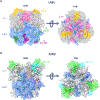Strategies of rational and structure-driven vaccine design for Arenaviruses
- PMID: 38908736
- PMCID: PMC12010953
- DOI: 10.1016/j.meegid.2024.105626
Strategies of rational and structure-driven vaccine design for Arenaviruses
Abstract
The COVID-19 outbreak has highlighted the importance of pandemic preparedness for the prevention of future health crises. One virus family with high pandemic potential are Arenaviruses, which have been detected almost worldwide, particularly in Africa and the Americas. These viruses are highly understudied and many questions regarding their structure, replication and tropism remain unanswered, making the design of an efficacious and molecularly-defined vaccine challenging. We propose that structure-driven computational vaccine design will contribute to overcome these challenges. Computational methods for stabilization of viral glycoproteins or epitope focusing have made progress during the last decades and particularly during the COVID-19 pandemic, and have proven useful for rational vaccine design and the establishment of novel diagnostic tools. In this review, we summarize gaps in our understanding of Arenavirus molecular biology, highlight challenges in vaccine design and discuss how structure-driven and computationally informed strategies will aid in overcoming these obstacles.
Keywords: Arenavirus; Computational vaccine design; Lassa virus; Mammarenavirus; Vaccine.
Copyright © 2024 The Authors. Published by Elsevier B.V. All rights reserved.
Conflict of interest statement
Declaration of competing interest C.T.S. has received unrelated research funds from Navigo Protein GmbH, Halle (Saale), Germany. The authors declare that they have no known competing financial interests or personal relationships that could have appeared to influence the work reported in this article.
Figures






References
-
- A Lassa Fever Vaccine Trial in Adults and Children Residing in West Africa, 2024. A Lassa Fever Vaccine Trial in Adults and Children Residing in West Africa [Internet]. [cited 2024 Apr 8]. Available from: https://clinicaltrials.gov/study/NCT05868733#more-information.
-
- Albariño César G., Bird Brian H., Chakrabarti Ayan K., Dodd Kimberly A., Mike Flint, Éric Bergeron, et al., 2011. Oct 1. The major determinant of attenuation in mice of the Candid1 vaccine for argentine hemorrhagic fever is located in the G2 glycoprotein transmembrane domain. J. Virol. 85 (19), 10404–10408. - PMC - PubMed
Publication types
MeSH terms
Substances
Grants and funding
LinkOut - more resources
Full Text Sources

